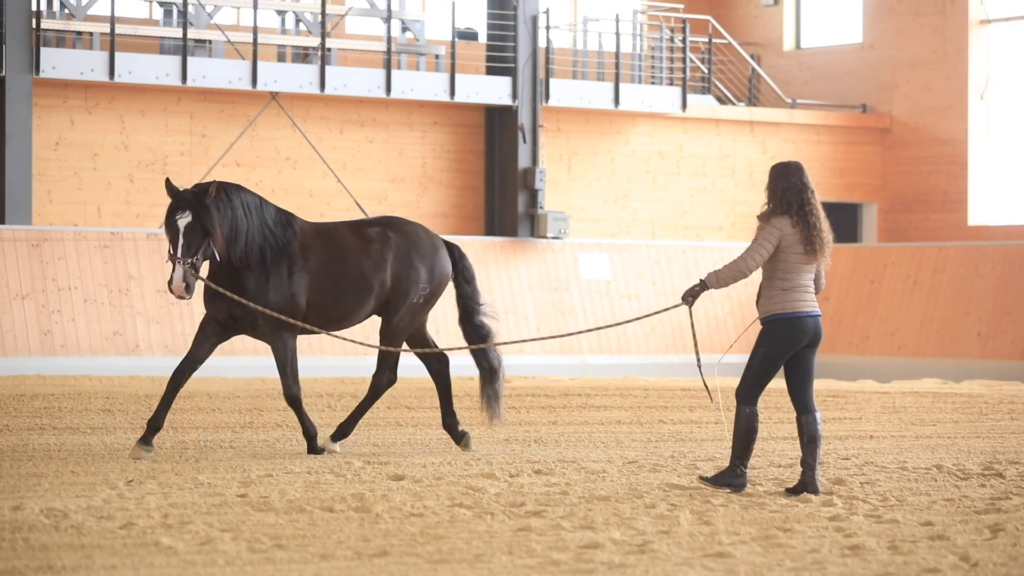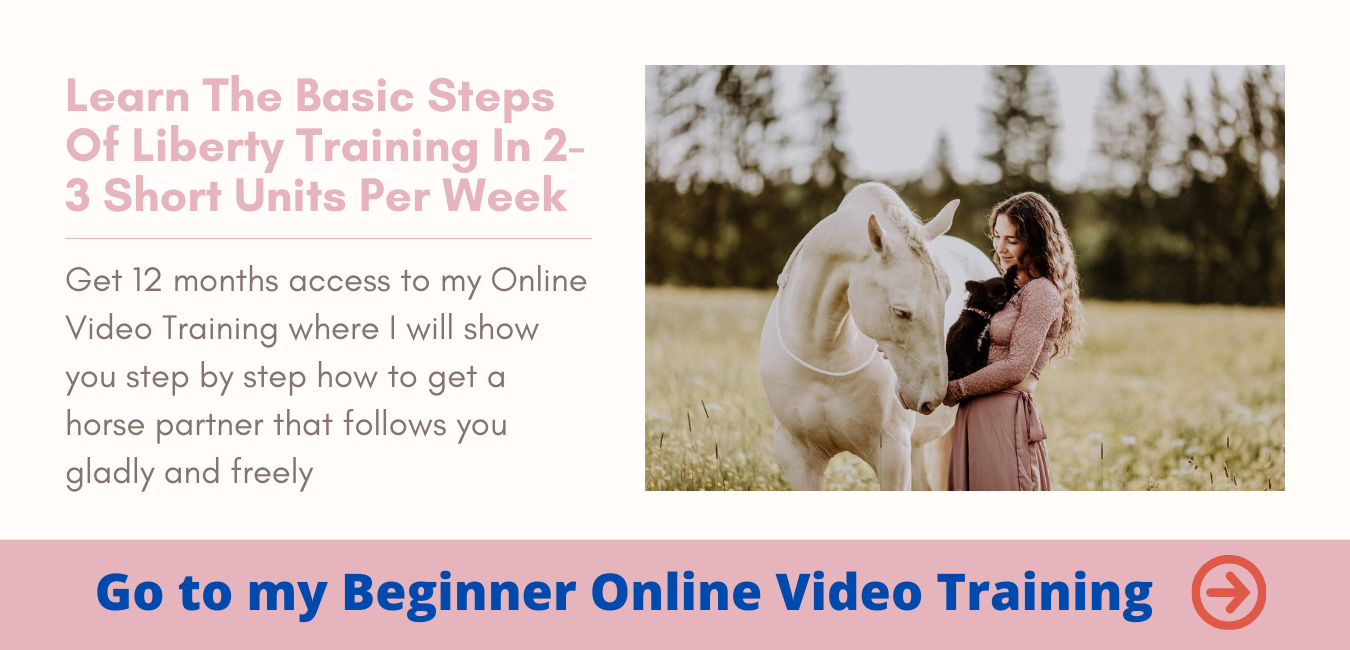If we also want to work “faster” with our horses in liberty work than we do at a walk, we can’t get around either enhancing our sport program or getting our horse to circle around us.
Today I want to talk about the pros and cons of both – and how you can clearly differentiate circling for your horse from lunging.
Because many horses start to mix the two quite quickly, or only offer the variation they like better.
But of course we want to be able to control how far our horses move away from us – and with how much energy they run around us.
The classic lunging
You probably know classical lunging yourself, don’t you?
Here the horse is sent around you on a fairly large circle in position and bend in a lean – in the best case. Horses have to learn to balance themselves on a circle and to walk in a gymnastic way.
Most horses are more like motorcycles that lean into a curve or even step on the gas to avoid falling over.
However, in doing so, the horses put extreme stress on their inner shoulder and are basically not in balance – so the training effect is zero (unless you just want to quickly buck out your energetic horse).
Your horse will neither loosen up nor become more supple with this circling – and that should definitely be your goal if lunging is basically part of your sensible training and is supposed to be valuable for your horse and his body.
Therefore, don’t think of your horse as a motorcycle, but rather as a train with several cars on rails.
In this case, the horse remains much more straight up on the circular track, loads both shoulders fairly evenly, and is bent – as if it had several wagons – along your circle.
I hope you can imagine it?
However, horses don’t learn this way of walking on a circle by themselves – you first have to show them how to use their body best, just like in riding.
Because if your horse remains more of a motorcycle and you still lunge regularly, your training is actually more harmful than beneficial.
The smaller the circle around you becomes, the more difficult it will be for your horse to exchange the motorcycle for the train – because small circles require much more (muscle) strength and coordination than large circles.
So always keep in mind that it takes some training before a horse can run gymnastically valuable on a circle.
Nevertheless, this is of course no reason not to lunge or circle a horse – because, as we all know, you grow with your tasks. And without challenge there is no development ?
Apart from that, of course, no horse will “break” if you let it run around you unbalanced from time to time.
It should only be your goal to make it more and more balanced and supple – and as always, it will only become that way through proper training. So let’s go I would say!
Bent through the body – off the train goes!
In order to teach your horse to bend his body properly, I can only wholeheartedly recommend a well-fitting cavesson!
Because your rope is attached above the nose, you can work much better in the right direction, because your impulses arrive directly.
If you give an impulse on the knotted halter instead, the direction of pull on the head is more to the outside instead of to the inside as we would like and you “support” your horse to throw the head to the outside and the inner shoulder towards the center of the circle.
At the end of the day, however, it’s all about your timing.
Nothing is more important than praising your horse for a step in the right direction!
In this case, the equipment is no longer important.
It can always work – but experience shows that it is easier with a cavesson ?
At the beginning it makes sense to lead your horse during this exercise.
This makes it easier for you to explain to your horse that he should take his nose slightly inwards, drop his neck and lift his inner shoulder.
To do this, give your horse small inward or downward impulses on the cavesson, stopping immediately when your horse has the right idea.
In the beginning, when your horse does not find the way down at all, you can lure him down with the help of treats after the tugging impulse on the cavesson until he understands what reaction you want from your horse.
Make sure that your horse does not “overreach” itself – because we usually tend to want too much and to “overbend” the horse’s neck.
Then the bend no longer goes through the whole body, but is “bent” in front of the shoulder, which in turn destroys the gymnastic effect.
As you can see, this exercise has a lot to do with intuition and above all with “learning to see”.
Because only if you have the right “final destination” in your mind’s eye, will you get there with your horse.
Head low, body bent, mind relaxed!
By the way, this exercise is also worth its weight in gold in stressful situations!
Because if you get your excited horse to lower its head using the impulses it is familiar with, it will also calm down quite quickly. The horse’s body and mind are closely connected and cannot be separated.
If the horse now lowers its head and relaxes its lower neck and perhaps even its jaw through a chewing exercise, the body signals to the mind that everything is in the green zone – and at some point the mind will also relax.
[su_youtube url=”https://youtu.be/Gd8WwfTK4GU”]
By the way, this also works if you let your horse chew (e.g. graze or eat a treat).
Because chewing and fleeing have always been mutually exclusive. And of course you can use this knowledge for yourself ?
This way into the depth and the first position and bend is simply immensely important, before it then goes to lungeing.
As I said, you can also work on the position and bend on the cavesson without a bit, but it simply takes longer at the beginning to loosen your horse’s jaw and encourage him to chew.
Of course, your horse’s noseband should not be too tight – he has to have room to chew.
By the way, I don’t recommend lunging on the snaffle, because we want to keep our horse’s mouth as fine as possible and especially at a distance a swinging rope pulls too much on the bit.
In the end, everything has its raison d’être as well as advantages and disadvantages.
Next week we will just continue where we left off.
And until then, I wish you and your horse a lot of fun on the way to relaxation and correct bending!
All the love,
Your Kenzie




